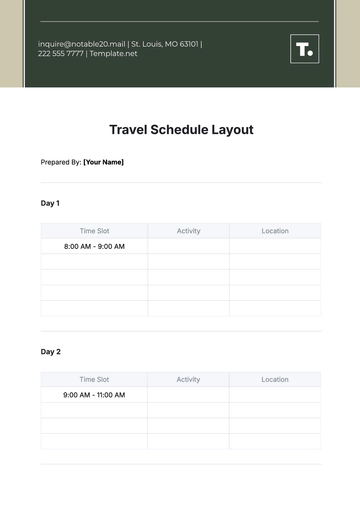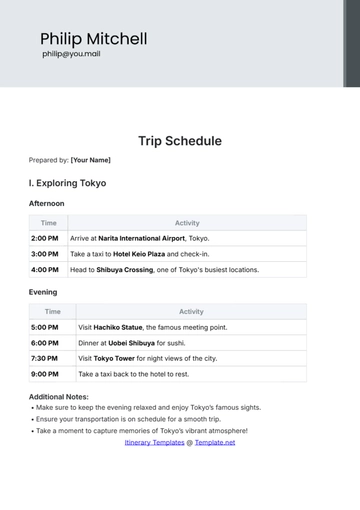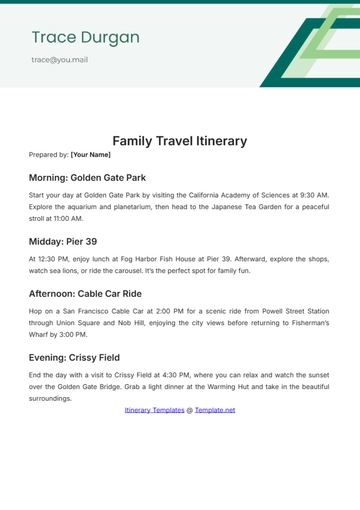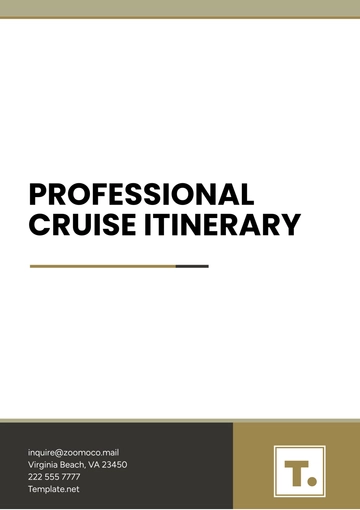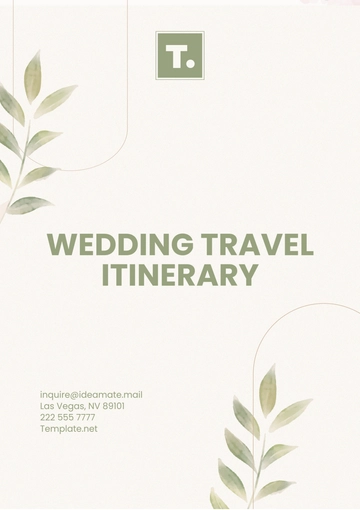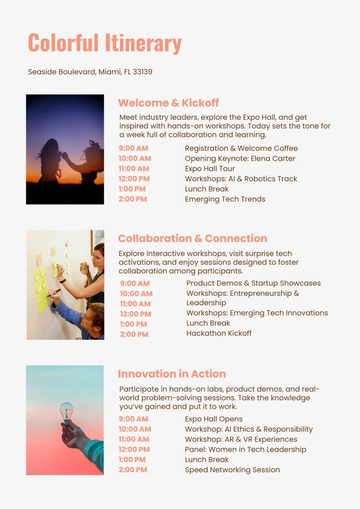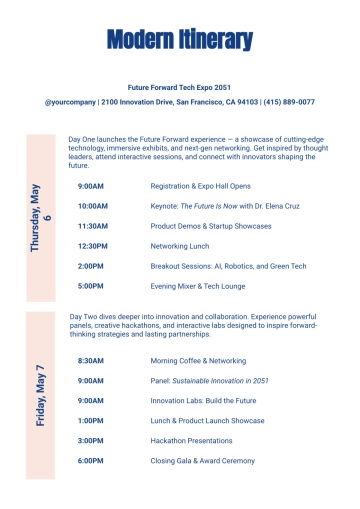Free 12 Day Italy Itinerary
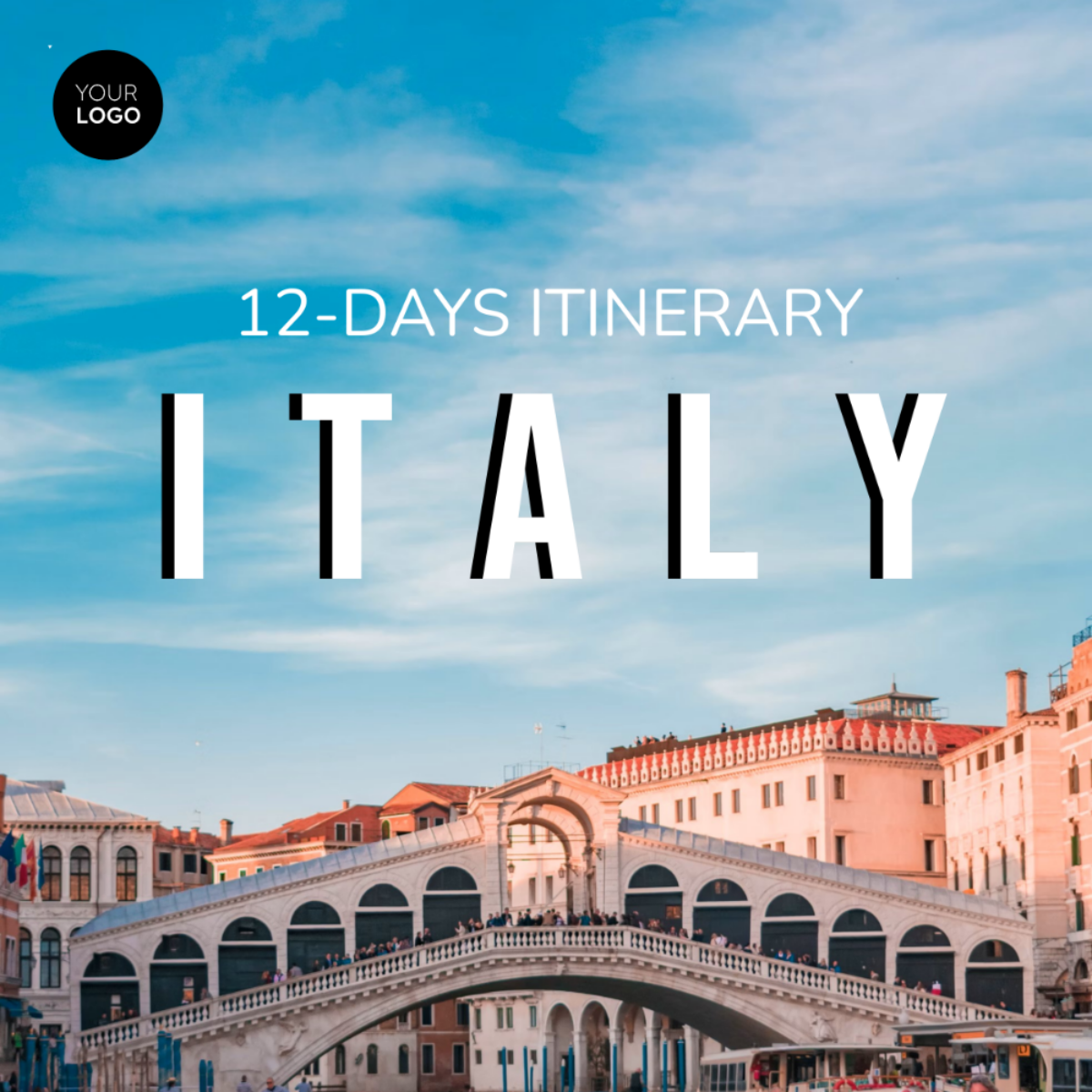
Date: [Date]
Prepared by: [Your Name]
Destination: Italy
Hello there! My name is [Your Name] and I'm excited to present to you an exciting twelve-day itinerary through Italy, the land of la dolce vita. Whether you're an art enthusiast, a gourmet traveler, or a history buff, Italy is a place that offers a unique blend of all that and more. We at [Your Company Name] promise to provide you with an immersive and personalized experience that will take you on an unforgettable journey through the flavors, sights, and sounds of this magnificent country.
Day 1-2: Rome
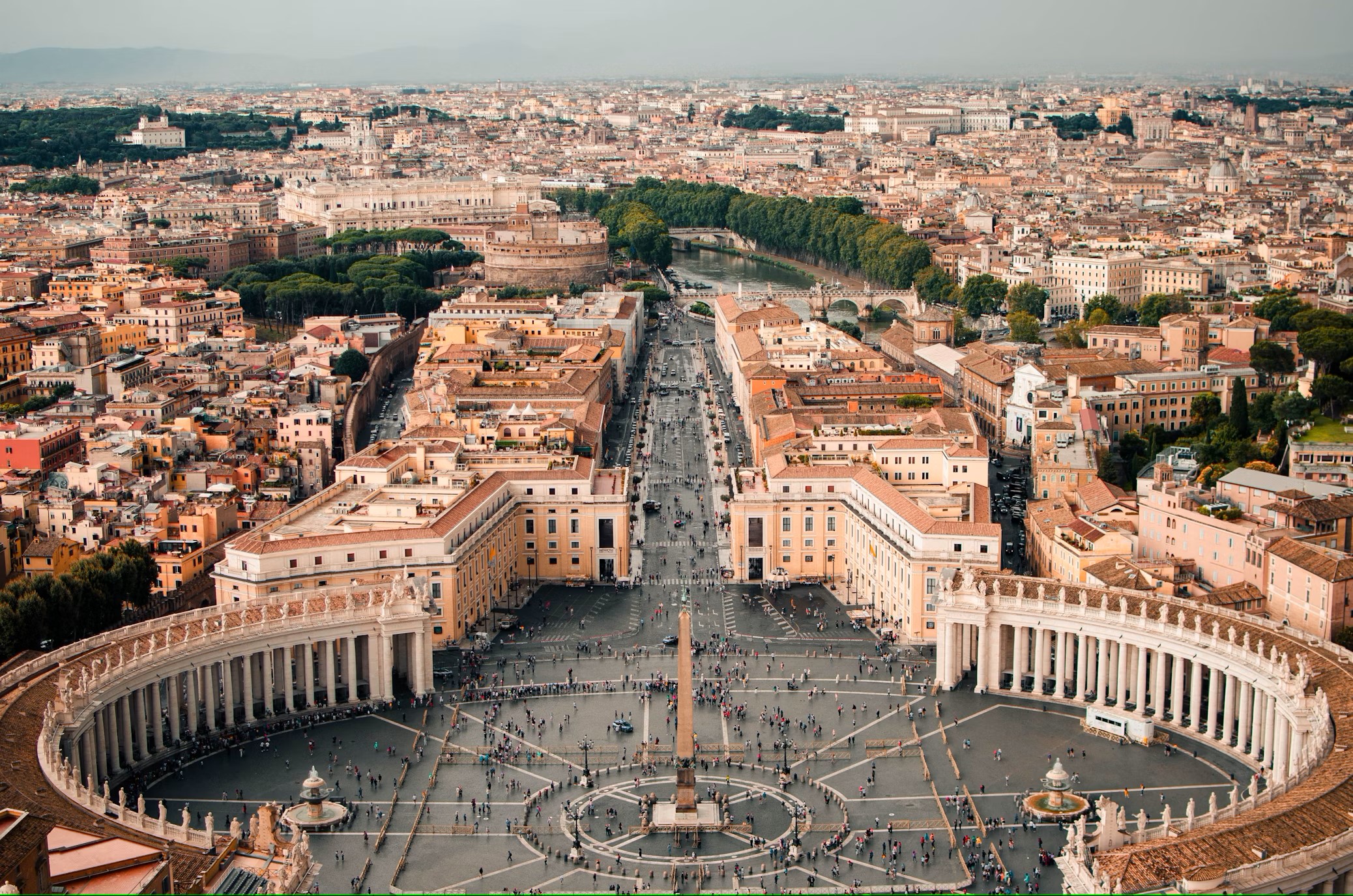
Start your trip in Rome, the capital city. Spend your first-day visiting iconic landmarks such as the Colosseum, Roman Forum, and Palatine Hill.
On the second day, explore Vatican City, including St. Peter's Basilica, Vatican Museums, and the Sistine Chapel.
When visiting Rome, there are several things you should keep in mind to make the most of your experience. Here are some dos and don'ts:
Do:
Visit the Colosseum, Roman Forum, and Palatine Hill: These iconic landmarks offer a glimpse into Rome's ancient history. Consider getting a combined ticket to save time and money.
Explore Vatican City: Don't miss St. Peter's Basilica, the Vatican Museums, and the Sistine Chapel. Consider booking tickets in advance to skip the long lines.
Take a stroll through Rome's historic neighborhoods: Wander through the narrow streets of Trastevere, Monti, and the Jewish Ghetto to discover charming piazzas, local cafes, and hidden gems.
Indulge in Roman cuisine: Try classic dishes like carbonara, cacio e pepe, supplì (fried rice balls), and gelato from reputable gelaterias.
Throw a coin into the Trevi Fountain: According to tradition, throwing a coin over your shoulder into the fountain ensures a return trip to Rome.
Don't:
Forget to validate your ticket: If you're using public transportation, make sure to validate your ticket in the machines before boarding buses or trams to avoid fines.
Feed the pigeons: While it may seem charming to feed the pigeons in Piazza San Pietro or Piazza del Popolo, it's discouraged as it contributes to hygiene issues and damages monuments.
Sit on the Spanish Steps: Sitting on the Spanish Steps is now prohibited to preserve the monument. Enjoy the view from the bottom or the top, but refrain from sitting on the steps themselves.
Ignore dress codes: When visiting religious sites like churches and basilicas, dress modestly. Avoid wearing revealing clothing, and cover your shoulders and knees out of respect.
Fall for scams: Be wary of pickpockets, street vendors selling counterfeit goods, and people offering unsolicited services or tours. Stick to reputable companies and always be cautious with your belongings.
By following these dos and don'ts, you can ensure a memorable and enjoyable visit to Rome while respecting its culture, history, and local customs.
Day 3-4: Florence

Travel to Florence by train or car. Spend your time exploring the city's rich Renaissance history.
Visit the Uffizi Gallery, Accademia Gallery (home to Michelangelo's David), Florence Cathedral (Duomo), and Ponte Vecchio.
When visiting Florence, there are several things you should keep in mind to make the most of your experience. Here are some dos and don'ts:
Do:
Visit the Duomo: Climb to the top of the Florence Cathedral's dome for panoramic views of the city. Be sure to also explore the cathedral's stunning interior.
Explore the Uffizi Gallery: See masterpieces by artists such as Michelangelo, Leonardo da Vinci, Botticelli, and Raphael. Consider booking tickets in advance to skip the lines.
Cross the Ponte Vecchio: Walk across this iconic bridge lined with shops selling jewelry, art, and souvenirs. Enjoy the views of the Arno River and the city skyline.
Wander through the Oltrarno: Explore the quieter side of Florence, known for its artisan workshops, local markets, and authentic trattorias. Visit attractions like Palazzo Pitti and the Boboli Gardens.
Try Florentine cuisine: Sample traditional dishes such as bistecca alla fiorentina (Florentine steak), ribollita (Tuscan soup), and lampredotto (tripe sandwich). Don't forget to indulge in gelato from one of the city's top gelaterias.
Don't:
Miss the Florence Cathedral's dress code: If you plan to visit the Duomo, remember to dress modestly. Avoid wearing shorts, sleeveless tops, or revealing clothing.
Forget to validate your train ticket: If you're using the train to travel around Italy, make sure to validate your ticket in the machines before boarding to avoid fines.
Haggle at the Ponte Vecchio: While bargaining is common in many markets, it's not customary to negotiate prices at the shops on the Ponte Vecchio. Expect to pay the marked price for items.
Take photos in the Uffizi Gallery: Photography is not allowed in many parts of the Uffizi Gallery to protect the artwork. Respect the rules and enjoy the art with your own eyes.
Eat near major tourist attractions: Restaurants and cafes near popular tourist sites tend to be overpriced and cater more to tourists. Venture a bit further to find more authentic and affordable dining options.
Day 5: Day trip to Pisa
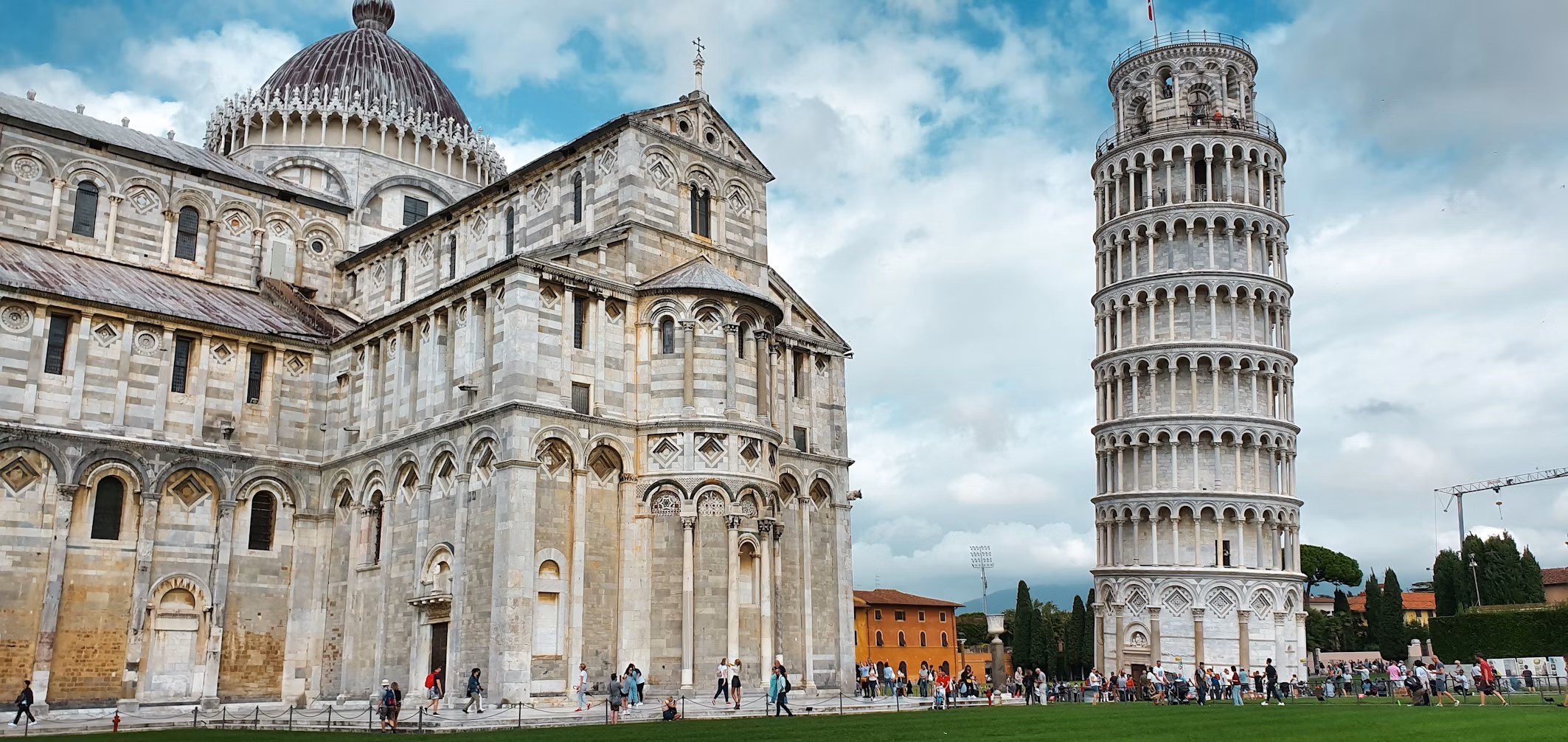
Take a day trip to Pisa to see the iconic Leaning Tower, Cathedral, and Baptistry in the Piazza dei Miracoli.
Pisa is a city located in the Tuscany region of central Italy. It is most famous for its iconic Leaning Tower, but it boasts a rich history, stunning architecture, and a vibrant cultural scene beyond this singular attraction.
Leaning Tower of Pisa: The Leaning Tower is one of the most recognizable landmarks in the world. Its famous tilt, caused by an unstable foundation, draws millions of visitors each year. It is part of the Piazza dei Miracoli (Square of Miracles), a UNESCO World Heritage Site that also includes the Pisa Cathedral (Duomo), the Baptistery, and the Camposanto Monumentale (Monumental Cemetery).
Pisa Cathedral (Duomo): A magnificent example of Romanesque architecture, the Pisa Cathedral is adorned with intricate marble facades, stunning bronze doors, and beautiful interior artwork. It is a masterpiece of medieval architecture and a must-visit attraction in Pisa.
Pisa Baptistry: Adjacent to the cathedral, the Pisa Baptistry is a circular building renowned for its acoustics and stunning architecture. Its marble facade features intricate carvings and sculptures.
Pisa's Historic Center: Beyond the Piazza dei Miracoli, Pisa's historic center is filled with charming medieval streets, lively piazzas, and elegant palaces. Visitors can wander through the city's picturesque neighborhoods, explore local markets, and admire historic buildings.
University of Pisa: Founded in 1343, the University of Pisa is one of the oldest universities in Italy and boasts a prestigious academic reputation. Its beautiful campus is located near the Arno River and features historic buildings, libraries, and botanical gardens.
River Arno: The Arno River flows through Pisa, adding to the city's scenic beauty. Visitors can enjoy leisurely walks along the riverbanks, cross historic bridges, and take boat tours to admire Pisa's landmarks from the water.
Overall, Pisa offers much more than just the Leaning Tower. It is a city steeped in history, culture, and architectural marvels, making it a rewarding destination for travelers interested in exploring the treasures of Tuscany.
Day 6-7: Venice

Travel to Venice and spend two days exploring the unique canals, bridges, and architecture of this romantic city.
Visit St. Mark's Square, St. Mark's Basilica, and Doge's Palace, and take a gondola ride along the Grand Canal.
Venice is a city located in northeastern Italy, renowned for its unique and picturesque setting. Built on a group of 118 small islands separated by canals and linked by bridges, Venice is often referred to as the "City of Canals" or the "Floating City." It is one of the most romantic and enchanting cities in the world, attracting millions of visitors each year.
Grand Canal: The Grand Canal is the main waterway that winds through the heart of Venice. Lined with elegant palaces, churches, and colorful buildings, it is the city's main thoroughfare and a stunning sight to behold. Visitors can take Vaporetto (water bus) rides along the Grand Canal for a unique perspective of Venice's architecture and landmarks.
St. Mark's Square (Piazza San Marco): The main square of Venice, St. Mark's Square is surrounded by historic buildings, including St. Mark's Basilica, the Doge's Palace, and the Campanile (bell tower). It is a bustling hub of activity, filled with cafes, shops, street performers, and tourists.
St. Mark's Basilica: A masterpiece of Byzantine architecture, St. Mark's Basilica is adorned with stunning mosaics, marble columns, and intricate artwork. It is one of the most important religious sites in Venice and a symbol of the city's wealth and power during the Middle Ages.
Doge's Palace (Palazzo Ducale): Adjacent to St. Mark's Basilica, the Doge's Palace served as the residence of the Doge (ruler) of Venice and the seat of government. It is a magnificent example of Venetian Gothic architecture and houses an impressive collection of artwork and historical artifacts.
Venetian Islands: Beyond the main island of Venice, visitors can explore the surrounding islands of Murano, Burano, and Torcello. Murano is famous for its glassmaking tradition, Burano for its colorful houses and lace-making heritage, and Torcello for its historic churches and archaeological sites.
Gondola Rides: Gondolas are traditional flat-bottomed boats that have been used for centuries as a mode of transportation in Venice's narrow canals. Today, gondola rides are a popular tourist activity, offering a romantic and leisurely way to explore the city's waterways.
Venetian Cuisine: Venice is known for its delicious cuisine, which includes fresh seafood, risotto, Cicchetti (Venetian tapas), and traditional desserts like tiramisu and Fratelli (Venetian fritters). Visitors can enjoy dining at local trattorias, osterias, and bacari (wine bars) to sample authentic Venetian dishes.
Overall, Venice is a city of unparalleled beauty, history, and culture, with its unique blend of architectural wonders, artistic treasures, and romantic ambiance making it a must-visit destination for travelers from around the world.
Day 8-9: Cinque Terre
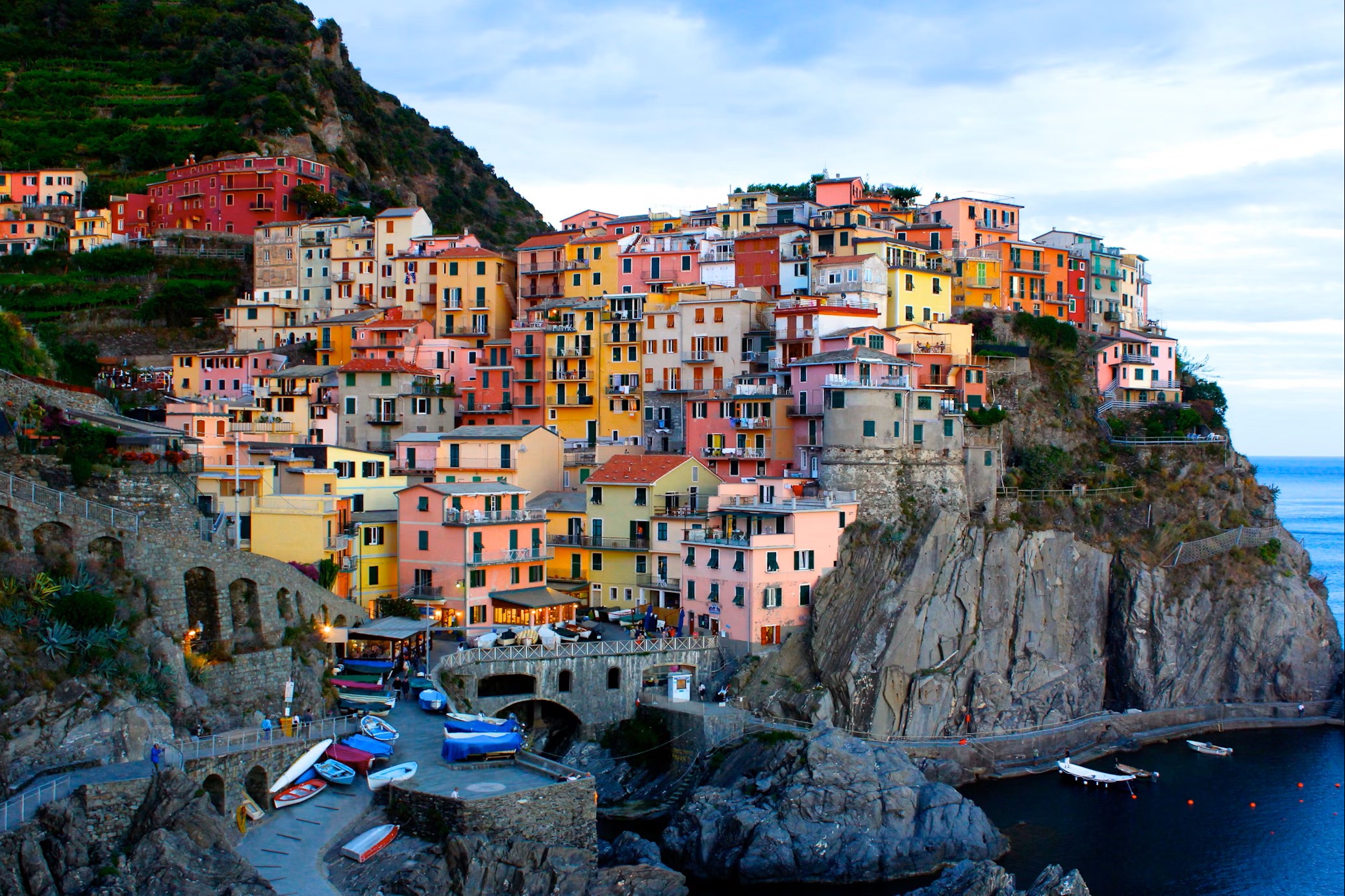
Head to Cinque Terre, a picturesque coastal region known for its colorful villages and scenic hiking trails.
Spend a day hiking between the five villages (Monterosso al Mare, Vernazza, Corniglia, Manarola, and Riomaggiore) or take a boat tour to admire the coastline from the sea.
Cinque Terre, which translates to "Five Lands," is a stunning coastal region located in the Liguria region of northwest Italy. It comprises five picturesque villages perched on rugged cliffs overlooking the Ligurian Sea. The villages, listed from north to south, are Monterosso al Mare, Vernazza, Corniglia, Manarola, and Riomaggiore.
Scenic Beauty: Cinque Terre is renowned for its breathtaking natural beauty, characterized by colorful houses clinging to cliffs, terraced vineyards, and crystal-clear turquoise waters. The rugged coastline is dotted with hidden coves, secluded beaches, and scenic hiking trails that offer panoramic views of the Mediterranean Sea and surrounding landscape.
Picturesque Villages: Each of the five villages in Cinque Terre has its unique charm and character. Visitors can explore narrow cobblestone streets, charming piazzas, and historic landmarks, including medieval churches and fortresses. Vernazza and Manarola are particularly known for their postcard-worthy views and photogenic scenery.
Hiking Trails: Cinque Terre is a paradise for outdoor enthusiasts, offering a network of scenic hiking trails that connect the five villages and traverse the rugged coastal landscape. The most famous trail is the Sentiero Azzurro (Blue Trail), which follows the coastline and offers stunning views of the sea and surrounding cliffs. Other popular trails include the Sentiero Rosso (Red Trail) and the high-altitude trails that lead to nearby villages and viewpoints.
Cinque Terre National Park: Much of the Cinque Terre region is protected as part of the Cinque Terre National Park, a UNESCO World Heritage Site. The park encompasses pristine natural habitats, including forests, vineyards, and marine reserves, and is home to a diverse array of flora and fauna.
Local Cuisine: Cinque Terre is known for its delicious Ligurian cuisine, which features fresh seafood, pesto, focaccia bread, and locally produced wines, including the famous Cinque Terre white wine. Visitors can enjoy dining at waterfront trattorias, seaside cafes, and traditional family-run restaurants that serve authentic regional dishes.
Local Culture: The villages of Cinque Terre have a rich cultural heritage, with centuries-old traditions and customs still preserved today. Visitors can experience local festivals, artisan workshops, and traditional activities, such as grape harvesting and olive oil production.
Overall, Cinque Terre offers a perfect blend of natural beauty, outdoor adventure, and cultural immersion, making it a must-visit destination for travelers seeking an unforgettable experience on the Italian Riviera.
Day 10-11: Tuscany
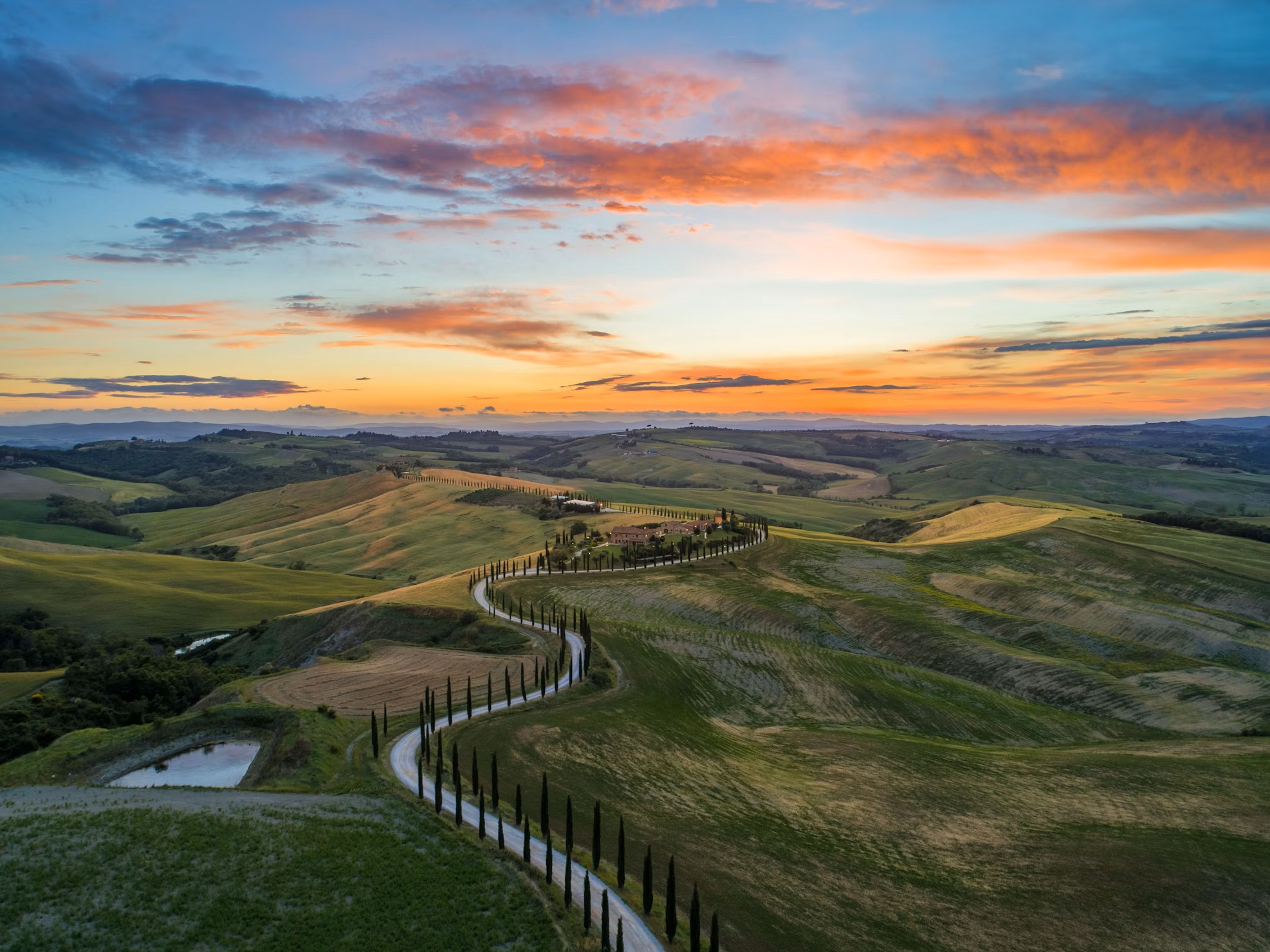
Explore the Tuscan countryside, famous for its rolling hills, vineyards, and medieval towns.
Visit charming towns like Siena, San Gimignano, and Montepulciano. Enjoy wine tasting at local wineries and indulge in Tuscan cuisine.
Tuscany is a region located in central Italy, renowned for its stunning landscapes, rich history, and cultural heritage. It is often considered one of the most beautiful and culturally significant regions in Italy and attracts millions of visitors each year.
Scenic Countryside: Tuscany is characterized by its rolling hills, vineyards, olive groves, and picturesque medieval towns. The countryside is dotted with charming villages, historic castles, and ancient hilltop settlements, offering breathtaking views at every turn.
Art and Architecture: Tuscany is home to some of the world's most iconic art and architecture. The city of Florence, the regional capital, is known as the birthplace of the Renaissance and boasts masterpieces by artists such as Michelangelo, Leonardo da Vinci, Botticelli, and Raphael. Other notable cities, including Siena, Pisa, and Lucca, are also renowned for their artistic and architectural treasures.
Historic Cities and Towns: Tuscany is dotted with historic cities and towns, each with its unique charm and character. Florence, with its magnificent Duomo, Uffizi Gallery, and Ponte Vecchio, is the cultural heart of the region. Siena is famous for its medieval architecture, including the stunning Piazza del Campo and Siena Cathedral. Pisa is known for its iconic Leaning Tower and beautiful Campo dei Miracoli (Field of Miracles).
Wine and Gastronomy: Tuscany is famous for its wine production, particularly its world-renowned Chianti wine. Visitors can explore the region's vineyards, wine estates, and wine cellars, tasting a variety of Tuscan wines, including Chianti, Brunello di Montalcino, and Vernaccia di San Gimignano. Tuscany is also celebrated for its delicious cuisine, which features fresh local ingredients, including olive oil, truffles, pecorino cheese, and Tuscan bread.
Cultural Events and Festivals: Tuscany hosts a variety of cultural events and festivals throughout the year, celebrating its rich heritage and traditions. These include the Palio di Siena, a historic horse race held in the heart of Siena's Piazza del Campo, and the Carnival of Viareggio, a colorful and festive celebration featuring elaborate floats and parades.
Outdoor Activities: Tuscany offers ample opportunities for outdoor activities, including hiking, cycling, horseback riding, and hot air ballooning. The region's diverse landscapes, from the rugged Apennine Mountains to the sandy beaches of the Tuscan coast, provide a scenic backdrop for outdoor adventures.
Overall, Tuscany offers a perfect blend of art, culture, history, and natural beauty, making it a must-visit destination for travelers seeking an authentic Italian experience.
Day 12: Return to Rome
Returning to Rome for your departure flight or onward journey typically involves traveling back to the city from whichever destination you have been exploring in Italy. Here's an elaboration on what this might entail:
Transportation: Depending on where you are in Italy, you have several options for returning to Rome. If you're in a nearby city or region, you might opt for a train, bus, or car rental. If you're further away, you might consider taking a domestic flight back to one of Rome's airports, such as Leonardo da Vinci–Fiumicino Airport (FCO) or Ciampino–G.B. Pastine International Airport (CIA).
Timing: It's essential to plan your return to Rome with enough time to catch your flight or continue your journey. Consider factors like travel time, transportation schedules, and potential delays to ensure you arrive in Rome with ample time to spare.
Accommodation: If you're arriving in Rome the day before your departure flight, you'll need accommodation for the night. Choose a hotel or Airbnb near the airport or in a convenient location with easy access to transportation links.
Final Explorations: If you have time before your departure, take advantage of any remaining hours to explore Rome further or revisit your favorite sights. You might want to stroll through a favorite neighborhood, indulge in a final Italian meal, or visit a landmark you missed during your earlier stay.
Airport Procedures: When it's time to head to the airport, ensure you allow enough time for check-in, security procedures, and any potential queues. If you're returning a rental car, factor in time for drop-off and shuttle transfers if necessary.
Departure: Once you've checked in and cleared security, make your way to the departure gate for your flight. Take one last look at Italy's beauty as you bid farewell to the country.
Onward Journey: If Rome is not your final destination and you're continuing your journey elsewhere, make sure you have all necessary travel documents, tickets, and accommodations arranged for your onward travel.
Returning to Rome for your departure flight or onward journey is a common conclusion to an Italian adventure. It allows you to enjoy the final moments of your trip in a familiar and convenient location before bidding arrivederci in Italy.
- 100% Customizable, free editor
- Access 1 Million+ Templates, photo’s & graphics
- Download or share as a template
- Click and replace photos, graphics, text, backgrounds
- Resize, crop, AI write & more
- Access advanced editor
Craft your dream Italian adventure with the 12-Day Italy Itinerary Template from Template.net. This customizable, downloadable, and printable itinerary offers the perfect roadmap for your journey through Italy's enchanting cities and breathtaking landscapes. Seamlessly editable in our AI Editor Tool, tailor each day to your preferences and create memories to last a lifetime. Unlock the beauty of Italy with ease, courtesy of Template.net.



